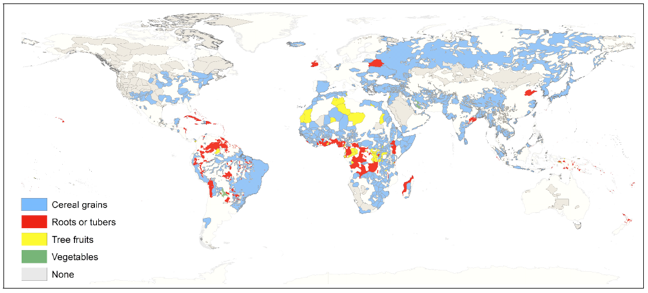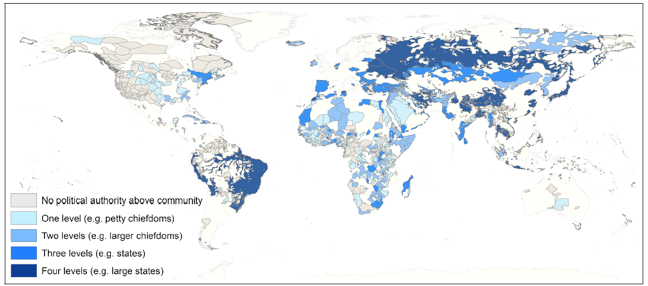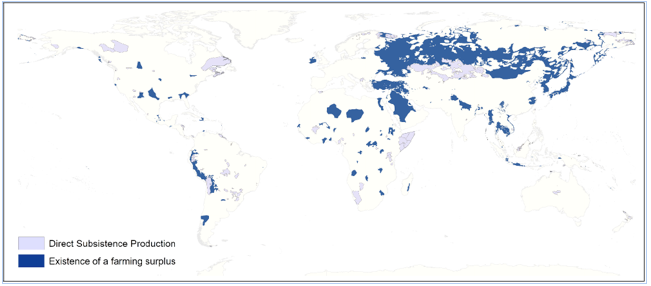Could the vulnerability of certain crops to theft and taxation be responsible for the development of social hierarchy and, eventually, the state? This is the main finding of BSE Working Paper (No. 842), “Cereals, Appropriability and Hierarchy,” by Joram Mayshar, Omer Moav, Zvika Neeman and Luigi Pascali. They find that one consistent difference between farming societies that developed complex hierarchies and those that did not was whether those societies relied on cereal grains or roots and tubers. The critical difference between cereals and tubers? Appropriability, in other words, how easy they are to steal and tax.
Geography and development
Economists and other researchers have long noticed that geography is correlated with economic development, and that, in particular, the tropics are underdeveloped. Much recent research has tried to disentangle whether this is mere coincidence or whether there really is something fundamental about the geography of the tropics that impedes economic growth. The authors of this paper propose a novel theory of how one seemingly innocuous feature of tropical geography may have impeded the development of social hierarchy which they argue allow for the elite to tax crops, and thereby develop hierarchy and social institutions. That feature? Throughout much of the tropics, tubers like yams, taro and manioc grow very well. Figure 1, which shows the major crops produced in a variety of pre-colonial societies, reflects this fact.

Cereals versus roots – a question of storage
Cereals and roots of various kinds are both commonly used as staple crops in different parts of the world, but there are important differences in the way they are harvested and consumed. Cereals like corn and rice must be harvested seasonally, once or at most twice per year, making storage necessary if they are to be relied on as a food source. Tubers in the tropics, in contrast, may generally be harvested at any time of year, making stockpiles much less urgent. In addition to this, tubers also spoil more quickly and so are more difficult to store.
Why does this matter? Well, to keep a stockpile, you have to defend it. In the fragmented and insecure world in which primitive farmers lived, one way to be safer from thieves was to have less to steal. If you were in an area where tubers grew well, they might be an attractive option even if grains were more productive, simply because you would get to keep more of what you grew.
If it can be stolen, it can be taxed
Farmers in climates where grain is the only good option, though, have little choice–if they want to keep their harvest, they need security. But because all farmers in an area will benefit from defense against bandits whether they pay their share or not, it may be difficult to raise the necessary funds unless those in authority have the ability to appropriate what they need–in other words, to collect taxes. The storability of grains which makes them easier to steal also makes it possible to tax them, as indeed they have been taxed by many societies in many places throughout history. So the same property of grain crops which makes them insecure also makes possible the emergence of a tax-collecting elite charged with protecting them.
Which came first, the surplus or the elite?
It is a widely acknowledged anthropological fact that social hierarchy emerges at around the same time farmers begin producing a surplus–in other words, more food than they need to support themselves and their immediate families. In contrast to conventional theories that suppose that the surplus came first, then the elites came to steal it, the authors propose that things should have happened the other way around – without an elite that taxed the farmers population size would adjust to prevent any surplus. By taxing, and in effect curtailing the growth rate of the population, the elite created the surplus required for its development. Thus it is this first level of hierarchy that allows surplus production, which most researchers agree is the first step in the subsequent development of towns, trade, and, eventually, economic growth. Some data on pre-colonial social hierarchy and farming surplus are presented in Figures 2 and 3.


What do the data say?
To test their theory, the authors seek out the best sources of data currently available on the social organization of indigenous peoples before contact with Europeans and the productivity of different types of crops in different land plots around the world. They find that areas where cereals are much more productive than tubers had more complex pre-contact social hierarchy, an effect which is statistically significant and robust to controlling for the overall productivity of the land, the prevalence of malaria, and other potential confounding factors.
They also find that farmers in areas where cereals are relatively more productive were more likely to produce a surplus. They furthermore find that when controlling for crop type, the effect of overall agricultural productivity on surplus production is essentially zero. This finding lends support to their argument that geography matters for economic development, but not in a simple or deterministic way. What matters is how geography shapes institutions–in this case, high productivity of tubers relative to cereals making hierarchy and state institutions less likely to develop.





The article is very useful for those also who’re investigating about social evolution also. Very interesting findings.
Thanks for sharing.